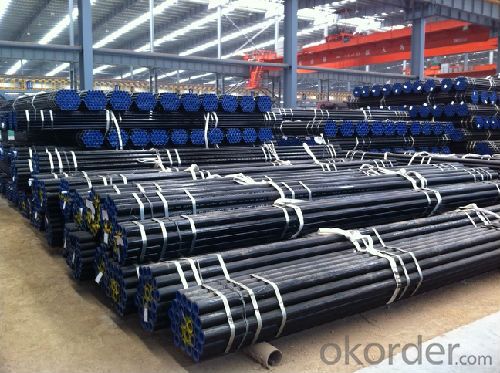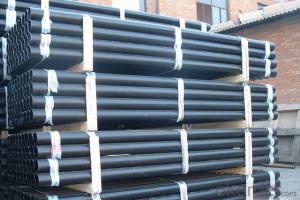API 5L GR.B Seamless Steel Pipe Best Seller Product
- Loading Port:
- Tianjin
- Payment Terms:
- TT or LC
- Min Order Qty:
- 25 m.t.
- Supply Capability:
- 10000 m.t./month
OKorder Service Pledge
OKorder Financial Service
You Might Also Like
1、Structure of API 5L GR.B Seamless Steel Pipe Best Seller Product:
Seamless pipe is formed by drawing a solid billet over a piercing rod to create the hollow shell. As the manufacturing process does not include any welding, seamless pipes are perceived to be stronger and more reliable. Historically seamless pipe was regarded as withstanding pressure better than other types, and was often more easily available than welded pipe.
2、Main Features of the API 5L GR.B Seamless Steel Pipe Best Seller Product:
• High manufacturing accuracy
• High strength
• Small inertia resistance
• Strong heat dissipation ability
• Good visual effect
• Reasonable price
3、API 5L GR.B Seamless Steel Pipe Best Seller Product Specification:
Standard | GB, DIN, ASTM ASTM A106-2006, ASTM A53-2007 |
Grade | 10#-45#, 16Mn 10#, 20#, 45#, 16Mn |
Thickness | 8 - 33 mm |
Section Shape | Round |
Outer Diameter | 133 - 219 mm |
Place of Origin | Shandong, China (Mainland) |
Secondary Or Not | Non-secondary |
Application | Hydraulic Pipe |
Technique | Cold Drawn |
Certification | API |
Surface Treatment | factory state or painted black |
Special Pipe | API Pipe |
Alloy Or Not | Non-alloy |
Length | 5-12M |
Outer Diameter | 21.3-610mm |
Grade | 20#, 45#, Q345, API J55, API K55, API L80, API N80, API P110, A53B |
Standard | ASME, ASTM |
1) Material:20#(ASTM A 106/A53 GRB.API5LGRB,GB),45#,16Mn,10#.
2) Specification range:OD:21.3-610mm,WT:6-70mm,length:6-12m or according to the requirement of clients.
3) Excutive standards:GB,ASME API5L.ASTM A 106/A53,Despite of the above standards,we can also supply seamless steel pipe with standard of DIN,JIS,and so on,and also develop new products according to the requirements of our clients!
4) Surface:black lacquered,varnish coating or galvanized.
5) Ends:Beveled or square cut,plastic capped,painted.
6) Packing:bundles wrapped with strong steel strip,seaworthy packing.
4、Packaging & Delivery
Packaging Details: | seaworthy package,bundles wrapped with strong steel strip |
Delivery Detail: | 15-30days after received 30%TT |
5、FAQ of API 5L GR.B Seamless Steel Pipe Best Seller Product :
①How is the quality of your products?
Our products are manufactured strictly according to national and internaional standard, and we take a test
on every pipe before delivered out. If you want see our quality certifications and all kinds of testing report, please just ask us for it.
Guaranteed: If products’ quality don’t accord to discription as we give or the promise before you place order, we promise 100% refund.
②How about price?
Yes, we are factory and be able to give you lowest price below market one, and we have a policy that “ for saving time and absolutely honest business attitude, we quote as lowest as possible for any customer, and discount can be given according to quantity”,if you like bargain and factory price is not low enough as you think, just don’t waste your time.Please trust the quotation we would give you, it is professional one.
③Why should you chose us?
Chose happens because of quality, then price, We can give you both.Additionally, we can also offer professional products inquiry, products knowledge train(for agents), smooth goods delivery, exellent customer solution proposals.Our service formula: good quality+good price+good service=customer’s trust
SGS test is available, customer inspection before shipping is welcome, third party inspection is no problem.
6、Seamless Pipe ASTM A106/53 Images:


- Q:How are steel pipes used in the manufacturing of solar power systems?
- Steel pipes are used in the manufacturing of solar power systems primarily for structural support and to house electrical wiring. They provide a sturdy framework for mounting solar panels, ensuring stability and durability. Additionally, steel pipes are utilized for underground wiring installations, protecting the electrical connections within the solar power system.
- Q:What are the thermal properties of steel pipes?
- Steel pipes have excellent thermal conductivity, allowing them to efficiently transfer heat. They also have a high melting point, making them suitable for high-temperature applications. Moreover, steel pipes have a low coefficient of thermal expansion, meaning they can withstand significant temperature changes without warping or deforming.
- Q:How are steel pipes used in mining?
- Steel pipes are widely used in mining operations for various purposes. One of the primary uses of steel pipes in mining is for transporting materials such as water, slurry, and other liquids. These pipes are durable and can withstand the harsh conditions often found in mining environments, making them suitable for the transportation of materials over long distances. Steel pipes are also used for ventilation systems in mines. Proper ventilation is crucial in mining to provide fresh air to workers and remove harmful gases and dust. Steel pipes are used to construct ventilation shafts and ducts that facilitate the flow of air throughout the mine, ensuring a safe working environment for the miners. Additionally, steel pipes are used in the construction of underground tunnels and mine shafts. These pipes provide structural support and reinforcement, helping to prevent collapses and maintain the stability of the mine. Steel pipes are known for their strength and durability, making them an ideal choice for these critical applications in mining. Another application of steel pipes in mining is for the extraction of resources. In some cases, steel pipes are used to create boreholes or wells to access underground deposits of minerals or water. These pipes are inserted into the ground, and various techniques such as drilling or hydraulic fracturing are used to extract the desired resources. Overall, steel pipes play a vital role in the mining industry, serving various purposes such as material transportation, ventilation, structural support, and resource extraction. Their strength, durability, and ability to withstand harsh conditions make them indispensable in mining operations.
- Q:How do steel pipes perform in high-temperature environments?
- Steel pipes perform well in high-temperature environments due to their inherent strength and heat resistance. They can withstand extreme temperatures without losing their structural integrity or deforming, making them suitable for various industrial applications such as steam pipelines, power plants, and refineries. The high melting point of steel allows it to maintain its mechanical properties even at elevated temperatures, ensuring reliable and efficient operation in high-temperature environments.
- Q:Can steel pipes be used for transporting slurry?
- Yes, steel pipes can be used for transporting slurry. Steel pipes are commonly used in various industries, including mining, construction, and oil and gas, for transporting different types of fluids, including slurry. Slurry is a mixture of solid particles suspended in a liquid, usually water, and steel pipes have the required strength and durability to handle the abrasive nature of slurry. Additionally, steel pipes have excellent resistance to corrosion, which is crucial when dealing with slurry that may contain corrosive elements. The smooth inner surface of steel pipes also helps to minimize friction and ensure efficient flow of the slurry. Overall, steel pipes are a reliable and commonly used choice for transporting slurry due to their strength, durability, corrosion resistance, and smooth inner surface.
- Q:How are steel pipes protected against corrosion in marine environments?
- Steel pipes are protected against corrosion in marine environments through various methods, including the use of protective coatings, cathodic protection systems, and selecting corrosion-resistant materials.
- Q:What are the different types of steel pipe supports?
- There are several different types of steel pipe supports, including pipe hangers, pipe clamps, pipe shoes, and pipe saddles. These supports are used to secure and stabilize pipes in various applications, such as plumbing, HVAC systems, and industrial piping systems.
- Q:How do you calculate the flow velocity in a steel pipe?
- To calculate the flow velocity in a steel pipe, you need to consider the principles of fluid mechanics and apply relevant equations. The most commonly used equation to calculate flow velocity is the Bernoulli equation, which relates the pressure, velocity, and elevation of a fluid. First, you need to determine the volumetric flow rate (Q) of the fluid passing through the pipe. This can be done by measuring the mass flow rate (m) or the volumetric flow rate directly using a flow meter. Once you have the volumetric flow rate, you can proceed with calculating the flow velocity (V). The flow velocity (V) is obtained by dividing the volumetric flow rate (Q) by the cross-sectional area (A) of the pipe. The cross-sectional area of the pipe can be determined using the formula A = πr^2, where r is the radius of the pipe. Therefore, the formula to calculate the flow velocity (V) in a steel pipe is: V = Q / A Keep in mind that this calculation assumes an ideal flow condition and does not account for any frictional losses or other factors that may affect the flow. In real-world scenarios, it is essential to consider additional factors like pipe roughness, fluid viscosity, and pipe diameter to obtain a more accurate estimation of flow velocity.
- Q:A333gr6 steel pipe and domestic material of the same?
- The SA333 standard in ASME (cryogenic seamless and welded nominal steel tubes), so A333-6 is a representation of the United States, followed by many countries.
- Q:Are steel pipes suitable for underground sewage systems?
- Yes, steel pipes are suitable for underground sewage systems. They are durable, strong, and resistant to corrosion, making them a reliable choice for carrying sewage underground. Additionally, steel pipes have a long lifespan and can withstand the pressure and weight of the surrounding soil, making them a suitable option for underground sewage systems.
1. Manufacturer Overview |
|
|---|---|
| Location | |
| Year Established | |
| Annual Output Value | |
| Main Markets | |
| Company Certifications | |
2. Manufacturer Certificates |
|
|---|---|
| a) Certification Name | |
| Range | |
| Reference | |
| Validity Period | |
3. Manufacturer Capability |
|
|---|---|
| a)Trade Capacity | |
| Nearest Port | |
| Export Percentage | |
| No.of Employees in Trade Department | |
| Language Spoken: | |
| b)Factory Information | |
| Factory Size: | |
| No. of Production Lines | |
| Contract Manufacturing | |
| Product Price Range | |
Send your message to us
API 5L GR.B Seamless Steel Pipe Best Seller Product
- Loading Port:
- Tianjin
- Payment Terms:
- TT or LC
- Min Order Qty:
- 25 m.t.
- Supply Capability:
- 10000 m.t./month
OKorder Service Pledge
OKorder Financial Service
Similar products
New products
Hot products
Related keywords






























